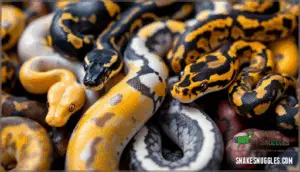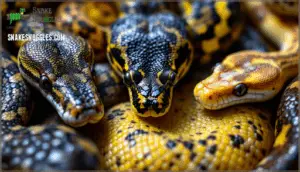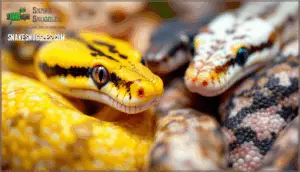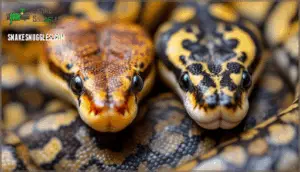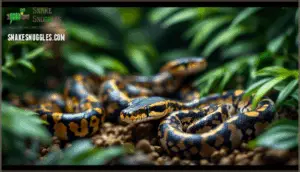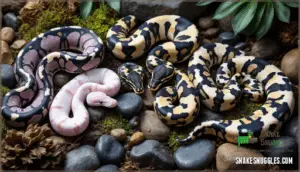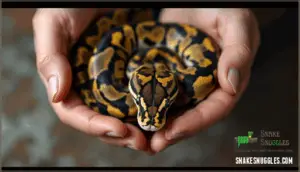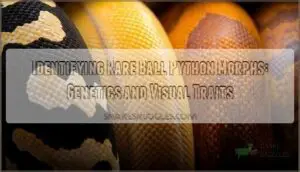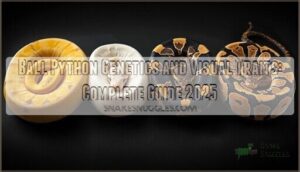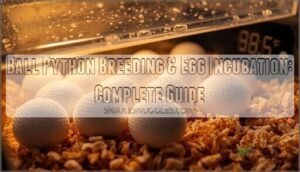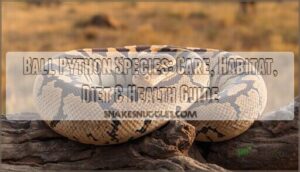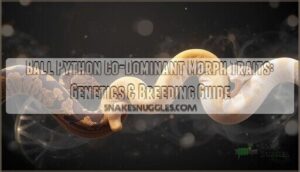This site is supported by our readers. We may earn a commission, at no cost to you, if you purchase through links.
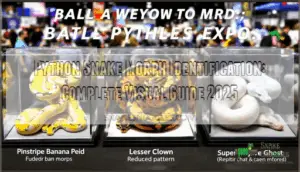 You walk into a reptile expo and spot what the vendor calls a "pinstripe banana pied." Another table displays a "lesser clown," while a third booth advertises "super mojave ghosts." Without a decoder ring, python snake morph identification feels like learning a foreign language.
You walk into a reptile expo and spot what the vendor calls a "pinstripe banana pied." Another table displays a "lesser clown," while a third booth advertises "super mojave ghosts." Without a decoder ring, python snake morph identification feels like learning a foreign language.
Ball pythons can express over 4,000 distinct genetic combinations, each with specific visual markers that separate a $50 snake from a $5,000 investment. The difference between identifying a co-dominant trait versus a recessive one determines whether your breeding project succeeds or fails.
Learning to read color patterns, scale arrangements, and eye pigmentation transforms confusing snake shopping into informed decision-making.
Table Of Contents
Key Takeaways
- Ball pythons display over 4,000 genetic combinations that follow three inheritance patterns—dominant traits need one gene copy to show, co-dominant traits create "super" forms with two copies, and recessive traits require two copies to become visible.
- Accurate morph identification depends on examining specific visual markers including overall color intensity, dorsal scale patterns, eye pigmentation variations, and distinctive blushing traits around the head and body.
- Morph value ranges from $50 to over $70,000 based on genetic rarity and breeding difficulty, with exclusive morphs like Dreamsicle having less than 0.1% breeding odds due to complex recessive gene combinations.
- Successful identification requires systematic visual inspection under proper lighting, comparison with reference databases, and consultation with experienced breeders when dealing with rare morphs or ambiguous genetic combinations.
Ball Python Morph Basics and Genetics
Ball python morphs represent genetic variations that create distinct color and pattern combinations. Understanding the basics of morph genetics helps you identify different types and predict breeding outcomes.
The following sections explain fundamental terminology and inheritance patterns you’ll encounter when working with these pythons.
What is a Ball Python Morph?
A ball python morph is a snake with a unique color or pattern created by genetic mutations that change how pigmentation appears on its scales. Breeders use selective breeding to preserve these visual traits. Over 4,000 ball python morphs exist today:
- Genetic mutations alter normal color patterns
- Each morph results from specific pigmentation changes
- Morphs are passed to offspring through inheritance
- Breeders began developing morphs three decades ago
- Morph identification relies on recognizing visual traits
Key Morph Terminology Explained
Understanding the language of ball python genetics will help you decode exactly what you’re seeing when you examine a snake’s colors and patterns. An allele definition refers to the specific gene version that creates morph characteristics. Genotype phenotype understanding connects the snake’s genetic makeup to its visible traits.
Heterozygous means one copy of a gene, while homozygous means two copies. Polygenic traits involve multiple genetic markers working together to produce complex ball python morph terminology patterns.
Genetic Mutations and Inheritance Types
Once you know the genetic terms, the next step is figuring out which mutation type you’re dealing with and how it passes to the subsequent generation. Genetic mutations alter gene expression by changing how DNA codes for color and pattern. These changes happen randomly in nature but can be selectively bred.
Understanding mutation inheritance helps you predict offspring traits using genetic charts. Each mutation follows specific inheritance patterns that determine whether it appears in the subsequent generation.
Dominant, Co-dominant, and Recessive Morphs
Three genetic pathways shape how morphs express themselves in ball pythons: dominant traits show up with just one gene copy, co-dominant traits create "super" forms when two copies pair together, and recessive traits need two copies to become visible.
Understanding these inheritance patterns lets you predict offspring outcomes:
- Dominant inheritance produces visible traits with a single gene, making selective breeding straightforward for breeders seeking consistent results.
- Co-dominant pairing combines two identical genes to create distinctive "super" morphs with intensified coloration or unique patterns.
- Recessive traits remain hidden in carriers but express when two copies unite, requiring careful breeding strategies to reveal desired characteristics.
- Mutation inheritance determines which snakes will display morphs across generations, guiding your breeding decisions and expectations.
Identifying Ball Python Morphs
Identifying a ball python morph means looking at specific visual clues on the snake’s body. You’ll examine the overall coloring, scale patterns, eye appearance, and any special markings that stand out.
Let’s walk through what to look for so you can recognize these distinctive traits.
Overall Color and Pigmentation Analysis
Color is the first thing you’ll notice when looking at a ball python, and it’s often your best clue to identifying its morph. Pay close attention to color saturation and intensity variations across the snake’s body. These pigmentation traits reveal what you’re working with. Some morphs show dramatic color intensity in their base coloring, while others display subtle pigment distribution patterns. Blushing analysis—where certain areas appear darker or flushed—helps narrow down possibilities. Look at overall color patterns and how pigmentation contrasts against the background. Pattern contrast matters too.
| Morph | Base Color | Pigmentation Pattern |
|---|---|---|
| Acid | Dark brown/black | Golden brown spots |
| Albino | Yellow/white | Pink eyes, minimal dark pigment |
| Axanthic | Silver/black | White markings, no yellow |
Recognizing Scale Patterns and Markings
Scale patterns are your roadmap to pinpointing what morph you’re looking at, and they often tell a different story than color alone. The dorsal patterns running down the snake’s spine vary dramatically between morphs. Some display clean, unbroken lines while others show pattern disruption or breaks.
Look for:
- Alien heads – distinctive head markings that resemble extraterrestrial features, common in certain morphs
- Aberrant markings – irregular or unusual pattern deviations that distinguish one morph from another
- Key visual traits – scale texture variations and pattern recognition that help narrow down possibilities
Spider morphs show characteristic thin, dark brown lines creating web-like patterns. Scaleless morphs lack the typical scale definition entirely. Yellow belly morphs display clean dorsal patterns contrasting sharply with their distinctive belly coloration. Pattern disruption and aberrant markings are key indicators when color alone proves ambiguous.
Eye and Head Color Variations
Your ball python’s eyes and head tell you almost as much as its body patterns do, and some morphs practically announce themselves through these features alone. Eye pigmentation varies considerably across morphs. Albino morphs display pink or red eyes due to absent pigmentation. Axanthic and other darker morphs show darker eye color with reduced pigmentation intensity.
Head markings provide important identification clues. Some morphs exhibit distinctive head patterns that hint at their genetic background. Color variations in head scales and eye rings often correlate with specific morph combinations, helping you narrow down possibilities when body patterns alone prove ambiguous.
Unique Features and Blushing Traits
Beyond body patterns and head markings, some ball pythons display distinctive visual traits that can seal the deal on identification. Blushing intensity represents one of the most telling features. This darkening of scales around the head and body varies considerably across morphs and acts as a key identifier. Feature consistency matters too—certain morphs show predictable blushing patterns that remain relatively stable throughout the snake’s life.
- Blushing and color change: Some morphs display enhanced pigmentation around the lips, chin, and sides that deepens with age or feeding cycles
- Pattern uniqueness: Trait combinations like alien head markings paired with specific blushing create distinctive signatures for identification
- Identification challenges: Overlapping blushing intensity between morphs requires comparing multiple characteristics simultaneously to avoid misidentification
These visual markers help you distinguish similar morphs when standard pattern analysis falls short.
Morph Classification and Popular Varieties
Ball python morphs fall into distinct genetic categories that determine how traits pass from parent to offspring. Understanding these classifications helps you recognize which morphs you’re looking at and how they’re likely to behave in breeding situations.
You’ll find that some morphs are more common and affordable, while others remain rare and highly sought after by collectors.
Common Ball Python Morphs and Traits
When you look at the spectrum of ball python morphs, you’ll notice that certain varieties show up again and again in collections and breeding programs—and there’s a good reason for that. The most popular ball python morphs balance striking morph color intensity with stable genetic traits.
Albino and Axanthic morphs display dramatic pattern element variations through their contrasting pigmentation. Banana morphs showcase gentle scale texture differences with tan bases and yellow blotches. These common ball python morphs remain accessible, offering breeders reliable morph identification guide references.
Beyond aesthetics, temperament traits remain consistent across most popular varieties. Understanding ball python morph characteristics helps you predict offspring when breeding or selecting specimens for your collection.
Notable Recessive, Dominant, and Co-dominant Morphs
The genetic inheritance pattern you choose determines everything about the morphs your breeding program can produce—and understanding the difference between these three categories is the key to predicting what you’ll get.
Dominant traits express themselves with just one gene copy, making them visible in every offspring that inherits the allele. Co-dominant combos create intermediate phenotypes or "super" forms when two copies appear together. Recessive genes require two copies to show visual markers, staying hidden in single-copy carriers.
Here’s what shapes your breeding outcomes:
- Dominant Ball Python Morphs display consistent visual markers across generations with predictable inheritance patterns
- Recessive Ball Python Morphs produce carrier offspring that may not show the trait but can pass genes forward
- Codominant Ball Python Morphs create distinct super forms when two copies combine in a single individual
- Morph Identification Guide reference charts help you track which genetic category each specimen belongs to before breeding
Morph Combinations and Super Forms
Combine two morphs together, and you might just discover a completely new look that doesn’t exist anywhere in nature. When you breed a ball python with one genetic mutation to another, the offspring can display entirely different visual outcomes.
Super morphs form when you pair co-dominant traits—breeding two copies of the same gene produces intensified coloration or pattern shifts. Your breeding strategies should account for undesirable combos that might occur.
Understanding combination genetics helps you predict which super morphs will emerge from specific pairings, making morph identification easier when you’re tracking multi-generational results.
Rare and High-Value Ball Python Morphs
When you’ve mastered the basics of ball python morphs, you’re ready to explore the rare and high-value varieties that command serious attention from collectors and breeders.
These exclusive morphs represent the cutting edge of genetic combinations and selective breeding, often available only through specialized breeders or in limited quantities.
What makes these morphs valuable is their rarity, unique genetic combinations, and the investment potential they hold for dedicated enthusiasts.
Rare Morphs and Their Genetic Origins
Rare ball python morphs arise from complex genetic origins that determine their market value and breeding difficulty. The Dreamsicle morph combines two recessive genes—lavender albino and piebald—creating less than 0.1% breeding odds. Banana morphs involve sex-linked inheritance, producing 95% offspring of one sex. The Sunset morph, discovered in 2012, commands $1,200–$2,500 due to genetic complexity. GHI morphs, identified in 2007, remain scarce among pure specimens.
The rise of unique morphs began when the first albino appeared in captive breeding. Understanding morph inheritance patterns helps you predict breeding outcomes and appreciate why certain morphs stay rare despite thousands of identified varieties worldwide.
Exclusive Morphs and Breeder-Only Lines
Breeders establish exclusive morphs by controlling initial production and release. These proprietary lines usually take three to seven years to stabilize through selective breeding, inbreeding to fix traits, and periodic outcrossing for genetic diversity. By 2025, fewer than 2% of new morphs launch as breeder-exclusive lines. Verification requires documented breeding trials across two generations and community consensus. Examples include the Genetic Hypo and Blizzard lines.
Some breeders maintain regional exclusivity for up to three years before international export, strategically controlling market availability and commanding premium prices during debut years.
High-Priced and Investment Morphs
Once breeders establish exclusivity, certain morphs command impressive prices. Investment-grade specimens like Sunset morphs reach $70,000, while Paradox and Scaleless het varieties sell for $30,000 and $45,000 respectively. Ball python morph prices depend heavily on genetic exclusivity and market volatility.
Breeding profitability requires substantial infrastructure—20 female and 10–20 male breeders—with clutches averaging 8 eggs valued from $1,000 to $22,000 before husbandry costs. Morph investment risk remains high due to price fluctuations from market saturation and shifting breeder preferences.
The rarest morphs, like specimens commanding $445,800, represent extreme outliers in this volatile market. The initial ball python cost can range widely from $50 to $1,500.
Step-by-Step Morph Identification Guide
Now that you understand how ball pythons inherit their traits, it’s time to learn how to spot different morphs in real snakes.
The next section walks you through practical steps for identifying morphs on your own. You’ll start with basic visual inspection and then move toward more confident identification using reference materials and expert guidance.
Visual Inspection Tips and Tools
You’ll want to slow down and examine your ball python like a detective searching for clues because the details matter for accurate morph identification. Get systematic about your visual inspection by using proper lighting techniques to reveal true color variations and avoid shadows that hide pattern details. Here’s what you need:
- Lighting Techniques: Use natural daylight or full-spectrum LED lighting to see authentic colors without distortion
- Magnification Tools: A hand lens or macro camera helps you spot fine scale patterns and subtle markings
- Pattern Recognition: Study the dorsal stripe, lateral patterns, and head markings systematically
- Image Databases: Reference reliable morph databases to compare your snake’s visual traits against known examples
- Expert Consultation: Document your findings with clear photos for breeder or veterinary verification when needed
Document everything you observe during your visual inspection of morphs.
Comparing With Known Morph Photos
Once you’ve got your notes from the inspection, the real work begins by placing your snake’s features side-by-side with reference photos from established morph collections. Start with color accuracy by comparing base coloration and pigmentation intensity under consistent lighting conditions.
Pattern matching is critical—examine dorsal stripes, lateral markings, and head patterns systematically against known examples. Account for lighting effects that can distort appearance in photos. Check regional variations since the same morph displays subtle differences across individual specimens.
Use high image quality references to spot fine scale details. This comparison process narrows down possibilities and confirms morph identification when features align consistently.
When to Consult an Expert or Breeder
If you’re finding it difficult to nail down the exact morph or hitting a wall with your visual analysis, that’s when reaching out to an expert or experienced breeder becomes your best move.
Breeders can confirm rare morphs and complex genetics while veterinarians address health concerns during the morph identification process.
Consulting experts for identification provides breeding guidance and investment advice when dealing with high-value ball python morph breeders.
Frequently Asked Questions (FAQs)
How do you determine a morphs genetic makeup?
Visual traits and breeding records reveal a morph’s genetic makeup. Punnett squares predict offspring traits based on parental lineage. Genetic testing confirms inherited mutations when visual identification isn’t conclusive.
Can morphs change appearance as they age?
Ball python morph appearance can shift with age. Color Fading and Pattern Shifts are common.
Environmental Factors and Diet Impact influence visual traits.
Genetic Drift affects pigmentation over time in some ball python morphs.
What breeding errors create unintended morph combinations?
Genetic misidentification leads to unexpected recessives appearing when hidden traits combine. Selective breeding without understanding genetic inheritance creates surprise morph combinations you didn’t plan for.
Incubation errors alter color expression.
Hybridization issues occur when lineage tracking fails.
How do you test for hidden recessive genes?
Proving hets requires breeding trials where suspected het carriers are paired with known visual recessives or other hets. Punnett squares predict offspring ratios.
Incubation records track results over multiple clutches to confirm genetic inheritance patterns and identify hidden recessive genetic markers.
What health issues link to specific morphs?
Some morphs carry shocking health risks that can severely impact quality of life. Spider morphs often exhibit neurological conditions like wobble syndrome, causing head shaking and balance issues.
Spider morphs often suffer neurological conditions like wobble syndrome, causing head shaking and balance issues that severely impact quality of life
Certain genetic predispositions create lethal combinations when paired incorrectly, affecting lifespan impacts and demanding strict health monitoring and breeding ethics.
Conclusion
Think of python snake morph identification like reading a language where every stripe tells a story. Once you understand the grammar of co-dominant genes and the vocabulary of pattern reduction, those expo tables transform from confusing displays into readable specimens.
You’ve learned to spot eye pigmentation shifts, decode blushing traits, and recognize the markers separating budget morphs from genetic goldmines. The decoder ring is now yours—each snake’s genetic history written across its scales, waiting for you to read it correctly.
- https://www.researchgate.net/publication/339918500_Searching_for_snakes_ball_python_hunting_in_southern_Togo_West_Africa
- https://www.9news.com.au/world/snake-with-smiley-faces/d121de50-5fa5-4d98-8839-c5d59e35dcb9
- http://basicgenetics.ansci.cornell.edu/lethal_alleles.php?section=mratios
- https://www.worldofballpythons.com/morphs/?
- https://reptilesmagazine.com/ball-python-morph-history/

